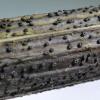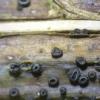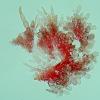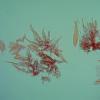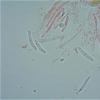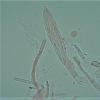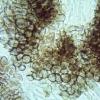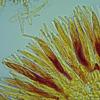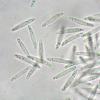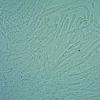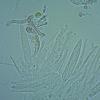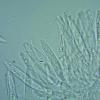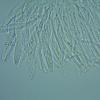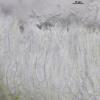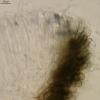
26-12-2025 21:19
Arnold BüschlenPithyella challaudii Pirou. Ist als Bryoparasit in

24-12-2025 17:08
Hulda Caroline HolteHello, I have found this propoloid ascomycete on

21-12-2025 09:32
Hello.A tiny ascomycete found embedded in wood in

21-12-2025 21:32
Pol DebaenstHello, Garden, Burgweg 19, Veurne, BelgiumOn 10/1

22-12-2025 23:38
Patrice TANCHAUDBonsoir, récolte sur un mur en pierre, apothéci
Pyrenopeziza carduorum or something different?
Jan Knuiman,
29-03-2017 19:33
I'm new to this forum and herewith my first post.
This ascomycete was found on a dead herb stem. Thistles are prevalent in the area where it was found, so the substrate could be thistle.
Maximum diameter apothecia was about 1 mm. Hymenium light to dark grey (images 01 and 02). Consistency jelly-like. Image 40 01 and 40 02 show multiseptate hairlike structures on the outside of the apothecium (stained in congo red). Image 100 01 shows the spores with various guttuli and size (n=14) 13.3-17.5 x 2.0-3.0 micron. Image 100 02 shows a typical ascus with spores. Image 100 03 shows part of the excipulum with round and angular cells, and image 100 04 shows asci in Melzers reagent (blueing at the tops of the asci).
My question is if this could be Pyrenopeziza carduorum and I welcome your comments.
Jan
Hans-Otto Baral,
29-03-2017 19:37

Re : Pyrenopeziza carduorum or something different?
Dear Jan
I would agree with this identification. Helpful would be to include also photos of the hymenium in water, regarding the paraphyses etc. But The genus is very clear, and spore size and guttules are what I remember for P. carduorum.
Zotto
I would agree with this identification. Helpful would be to include also photos of the hymenium in water, regarding the paraphyses etc. But The genus is very clear, and spore size and guttules are what I remember for P. carduorum.
Zotto
Jan Knuiman,
29-03-2017 20:22
Re : Pyrenopeziza carduorum or something different?
Thank you for your fast confirmation Zotto. Next time I'll include photos of the hymenium as well.
Kind regards, Jan
Kind regards, Jan
Hans-Otto Baral,
29-03-2017 20:33

Re : Pyrenopeziza carduorum or something different?
Your last photo is pretty good, only I would also need to see the same in living state (in water, and without pressure).
Michel Hairaud,
29-03-2017 21:03

Re : Pyrenopeziza carduorum or something different?
Hi Jan,
Welcome (bienvenue) on this forum where I see you for the first time it seems.
I agree with you and zotto (of course) as to this identification . The spores you show, though not in water are actually rather easy to recognize . I join a picture in water.
Amitiés
Michel
Welcome (bienvenue) on this forum where I see you for the first time it seems.
I agree with you and zotto (of course) as to this identification . The spores you show, though not in water are actually rather easy to recognize . I join a picture in water.
Amitiés
Michel
Jan Knuiman,
29-03-2017 22:26
Hans-Otto Baral,
29-03-2017 22:29

Re : Pyrenopeziza carduorum or something different?
Yes, but you must know that the asci are all dead, they look very different when alive. Also the paraphyses look dead. Either by pressure or when you have dried the apothecia the elements rapidly die and shrink and losse valuable plasmatic features.
I attach two rather bad photos of this species which show what I mean. Look at the arangement of the spores in the asci and the ample water below, also to the globose drops in the paraphyses.
I attach two rather bad photos of this species which show what I mean. Look at the arangement of the spores in the asci and the ample water below, also to the globose drops in the paraphyses.
Jan Knuiman,
29-03-2017 22:36
Re : Pyrenopeziza carduorum or something different?
Thanks Michel for your kind words of welcome. Yes, these typical spores, given their form and size, are relatively easy to recognize. In fact, I arrived without much trouble at P. carduorum on the basis of the paper of Gremmen, J. (1955): Taxonomical notes on mollisiaceous fungi. II. Some caulicolous Mollisia species inhabiting various hosts, mainly Compositae. [Pyrenopeziza soms als Mollisia] Fungus 25: 1-12.
Jan
Jan
Jan Knuiman,
29-03-2017 22:41
Re : Pyrenopeziza carduorum or something different?
Thanks Zotto. There is material left, so I'll try to find living asci and paraphyses.
Jan
Jan
